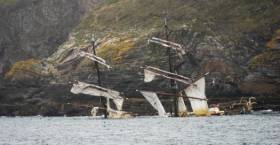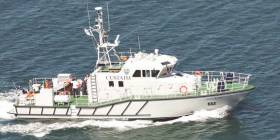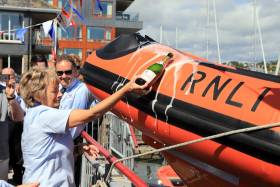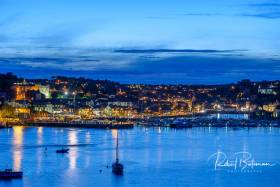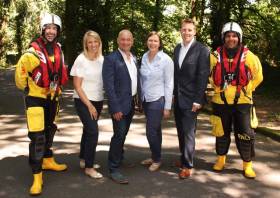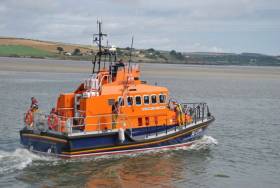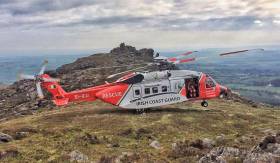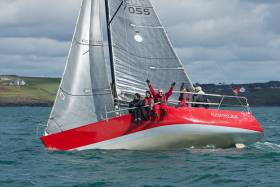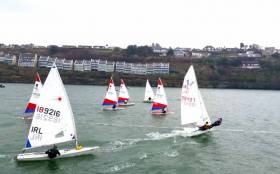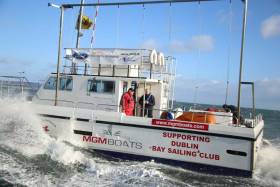Displaying items by tag: Kinsale
Kinsale Lifeboat Volunteer Jailed On Drugs Charges
One of the Kinsale RNLI volunteers honoured for their role in the rescue of 30 crew from the tall ship Astrid in July 2013 has been jailed for seven years on drug distrubution charges.
As The Irish Times reports, Liam O’Connell was sentenced to 10 years with three suspended after pleading guilty to possession of cannabis, cocaine and MDMA for sale or supply at his home just over a year ago.
At sentencing, the judge said O’Connell has exploited his status in the Kinsale community as an RNLI volunteer to participate in the drugs trade.
The Irish Times has more on the story HERE.
Drug Smuggling Investigation Sees Three Arrested & Yacht Impounded
#Crime - Three men are in custody and their yacht impounded in Cork on suspicion of drug trafficking.
As RTÉ News reports, the Naval Service detained the vessel, which had sailed from South America, off the Kerry coast yesterday (Wednesday 12 September).
The boat is currently undergoing forensic examination in Kinsale, though it is understood that no drugs had been found as of this afternoon.
This incident comes a fortnight after the Naval Service was involved in the detention of a catamaran with a “significant quantity of cocaine” in the English Channel.
#RNLI - With the sun shining down on the assembled crowd, the new Atlantic 85 B class lifeboat for Kinsale RNLI was officially named ‘Miss Sally Anne Baggy II - Never Fear, Baggy’s Here’ during a ceremony at the Kinsale lifeboat station on Saturday (25 August).
The lifeboat, which only went on service last month, was funded by Miss Sally Anne Odell, who has been a close friend of the station and a generous benefactor until her death last year.
The full name of the new lifeboat was the choice of the donor and reflects her sense of humour. It is to be a reminder to the lifeboat crew that their ‘godmother’ is always with them.
As previously reported on Afloat.ie, the Atlantic 85 class lifeboat replaces the Miss Sally Anne Baggy, which has been retired after 15 years of dedicated service that have seen her involved in countless high-profile incidents including the rescue of 30 young people from the training ship Astrid in 2013, and rescuing three fishermen from treacherous seas as their trawler Sean Anthony sank in 2016.
Opening the ceremony, Kinsale RNLI lifeboat operations manager Kevin Gould said: “This is a very special occasion for our lifeboat station and although it is tinged with sadness as Sally Anne is no longer with us, we want to give her lifeboat the naming ceremony befitting its status.
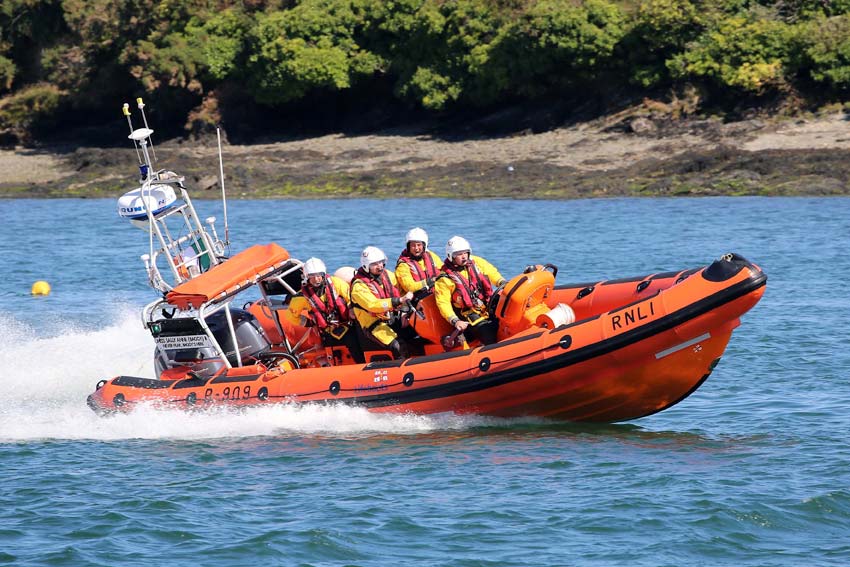 Sally Anne Baggy II - Never Fear, Baggy’s Here on the water off Kinsale | Photo: RNLI/Nicholas Leach
Sally Anne Baggy II - Never Fear, Baggy’s Here on the water off Kinsale | Photo: RNLI/Nicholas Leach
“Sally Anne was a lifelong supporter of the RNLI and was affectionately known to the crew as ‘The Godmother’. She will always be remembered by our community and we will forever be grateful for her care and affection. She funded the original Kinsale lifeboat and part of the station, and kept in close contact with the crew throughout the years.”
Robert Acton took the part of Miss Odell and gifted the lifeboat into the care of the RNLI. Accepting the lifeboat on behalf of theiInstitution, RNLI area lifesaving manager Brian O’Driscoll — who is a former lifeboat station coxswain with Castletownbere RNLI — spoke of how inshore lifeboats have been keeping people safe in this part of the world since 2003.
He praised the volunteers with Kinsale RNLI who, he said, “give up their time and are the embodiment of willingness and selflessness in helping others in need.”
Kinsale RNLI helm James Grennan was chosen to accept the lifeboat on behalf of the station and the vessel was named by Valerie Good, chair of the fundraising team who poured champagne over the bow of the lifeboat, a tradition that has been undertaken at every naming ceremony for many years.
The vote of thanks was given by Tricia Tyson, volunteer lifeboat press officer for the station, and the music was provided by a choir representing all Kinsale churches. Rev Peter Rutherford and Fr Peter Keogh delivered the service of dedication.
Many RNLI lifeboat stations were in attendance, including fellow Cork crews from Courtmacsherry, Crosshaven, Union Hall and Youghal, as well as Dunmore East in Waterford.
Kinsale Regatta Celebrates 222 Years As Ireland's Oldest
Celebrating 222 years, the oldest regatta in Ireland is set in one of Ireland's most spectacular harbours writes Bob Bateman. Kinsale Regatta in County Cork was a fun packed weekend, with many land-based events in addition to the traditional water activities. These range from ocean yachts to mixed dinghy racing, a long-distance swim around Sandycove Island and children's sailing.
Sitting outside Una Crosbie's Cafe drinking a traditional cup of tea (i.e tea leaves with a strainer) in balmy conditions gave a continental feel with live entertainment provided by the Blarney Brass and Reed Band.
From Crosbie's, it was possible to watch the dinghies wending their way down the slipway to participate in their various races.
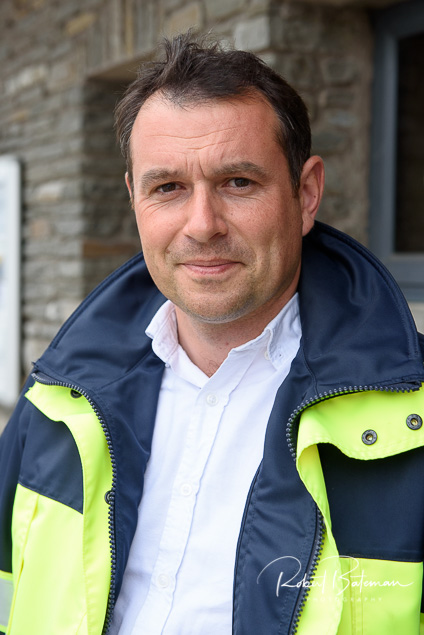 Kinsale Harbour Master Julian Renault Photo: Bob Bateman
Kinsale Harbour Master Julian Renault Photo: Bob Bateman
The start-finish line could be seen from our vantage point as the yachts returned from their race they hardened up at the Spit Buoy and the earlier finishers were two of the beautiful 2.4R single-handed dinghies sailed by both sailability and able-bodied people. Then the classic lines of the Dragons hove into view providing a magnificent special as they headed for the finish line.
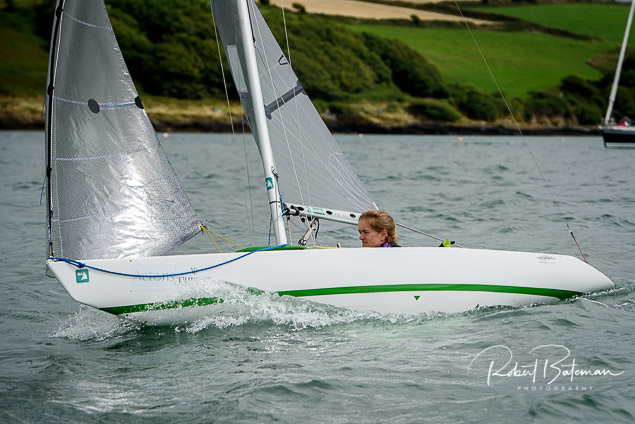 (Above and below) Kinsale's Para Euro Medal Winner Gina Griffin was competing in Kinsale Regatta Photo: Bob Bateman
(Above and below) Kinsale's Para Euro Medal Winner Gina Griffin was competing in Kinsale Regatta Photo: Bob Bateman
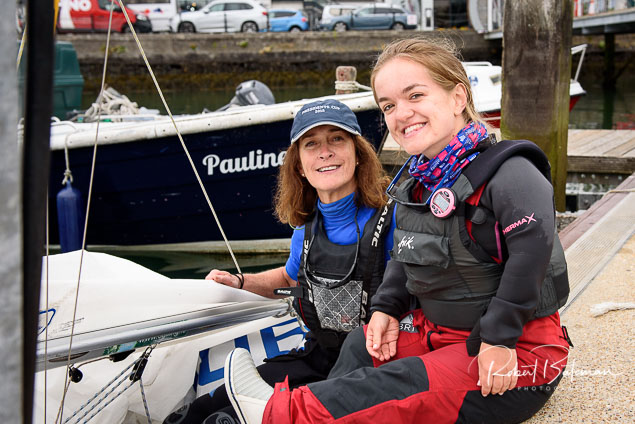
"Earlier finishers were two of the beautiful 2.4R single handed dinghies sailed by both sailability and able-bodied people"
Following on came the cruisers lead by John Godkin sailing 'Godot' followed by a plethora of smaller dinghies including the Toppers which are getting in some last minute practice before heading to China next week.
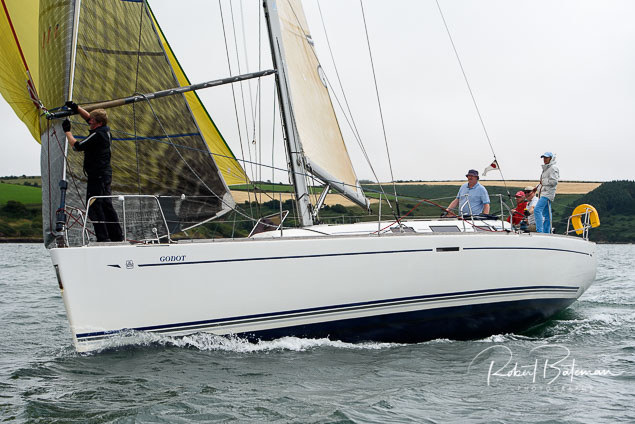 John Godkin's Godot Photo: Bob Bateman
John Godkin's Godot Photo: Bob Bateman
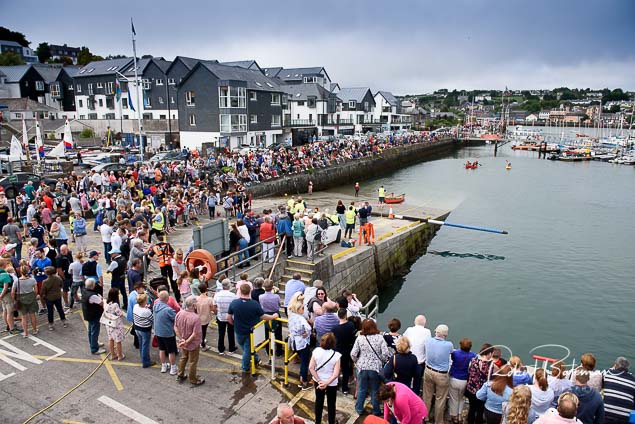 There were many shoreside activities to keep the large crowd entertained Photo: Bob Bateman
There were many shoreside activities to keep the large crowd entertained Photo: Bob Bateman
 (Above and below) A spectacular fireworks display lit up the sky over Kinsale on Sunday night Photos Bob Bateman
(Above and below) A spectacular fireworks display lit up the sky over Kinsale on Sunday night Photos Bob Bateman

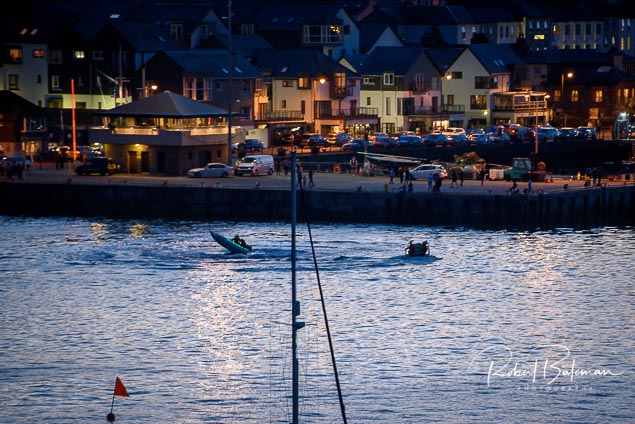
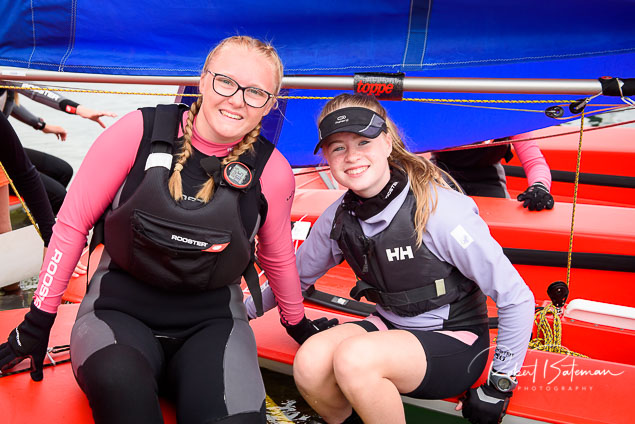
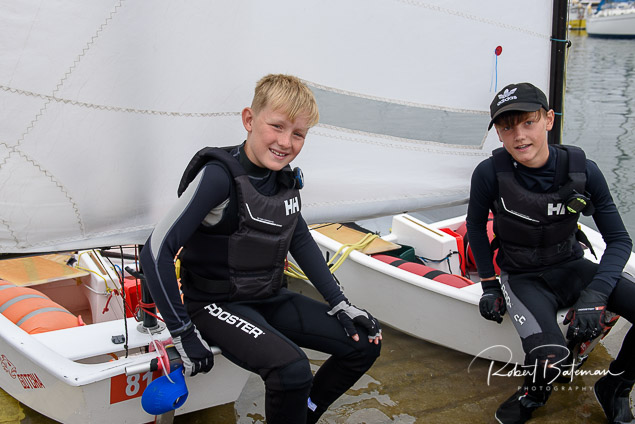
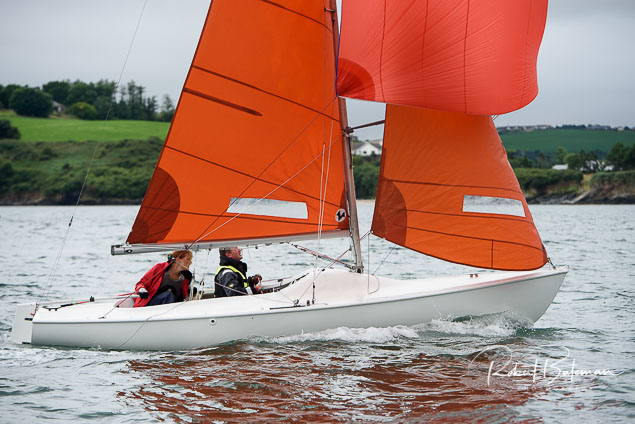
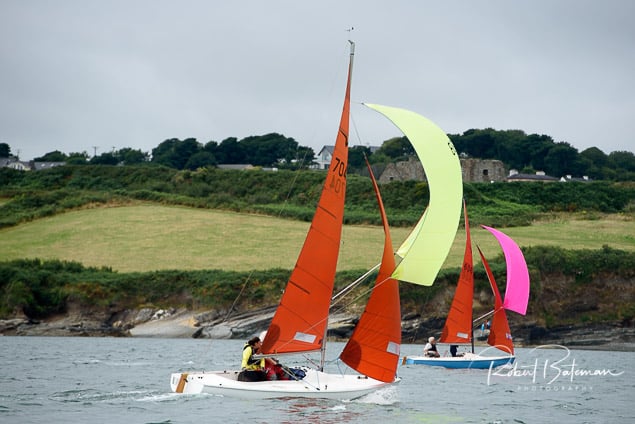
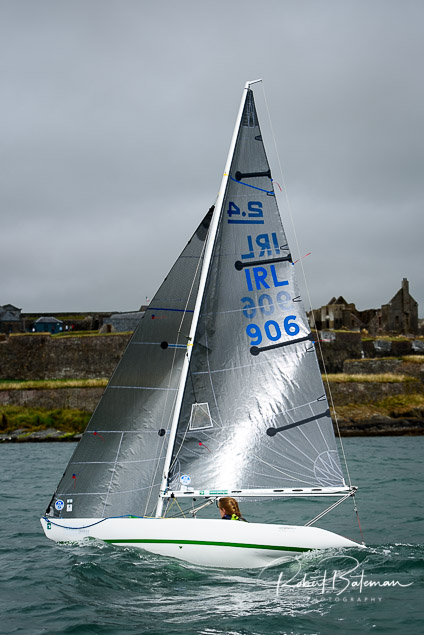
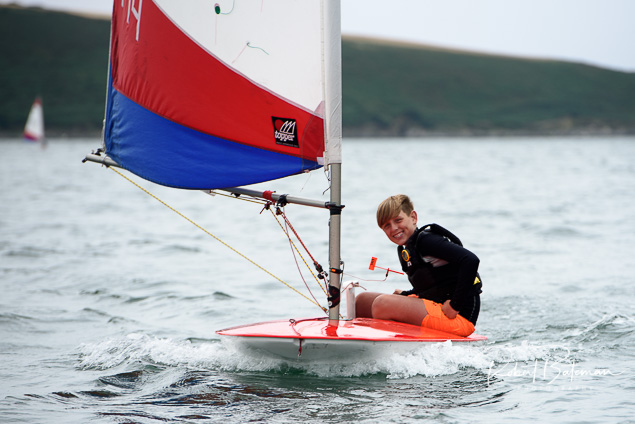
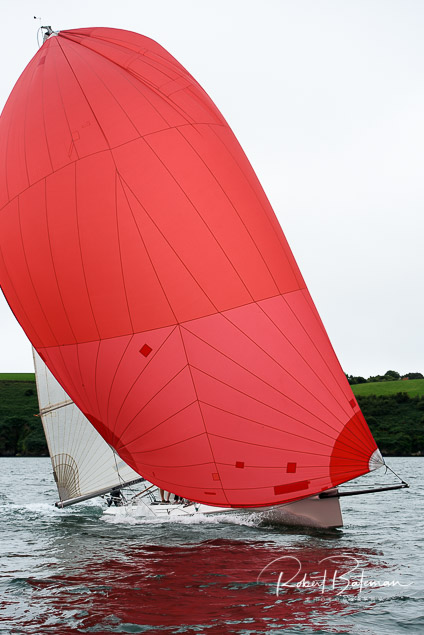
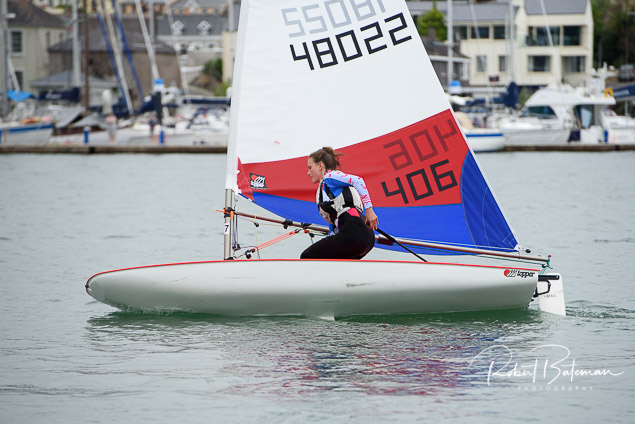
Cork Lifeboat Lunch Returns To Raise Vital Funds For The RNLI
#RNLI - The hugely successful Cork RNLI charity lunch and auction is set to return after an absence of five years.
The revamped fundraiser for Baltimore, Crosshaven and Kinsale’s RNLI lifeboat stations will take place in the 18th century mansion now home to the Maryborough Hotel in Douglas on Friday 5 October.
Cork has a long and proud association with the RNLI which goes back generations. The men and women who volunteer as lifeboat crew come from local communities and give hours of their time and dedication to the charity.
From the rescue of the Rambler crew by Baltimore RNLI during the Fastnet Race, to rescues of fishermen, divers, swimmers and boaters, the lifeboats and their crew provide an invaluable service.
Last year the Baltimore, Crosshaven and Kinsale RNLI lifeboat stations launched 86 times and brought 116 people to safety. Not every callout is life and death, but to the people involved in every mission, the lifeboats are their lifeline in times of trouble on the water.
The lunch and auction will get underway at 12.30pm with guests welcomed in the Orangery to the accompaniment of live music from Conor Ocean. This will be followed by a three-course lunch in the Sherrard Suite at 1.30pm.
Master of ceremonies Alan Shortt will provide the entertainment and lead the post-lunch auction and draw. The event will finish at 4pm.
RNLI fundraising committee members Avril O’Brien and David Doherty are looking forward to what promises to be an event to remember.
“We are delighted to reintroduce the RNLI lunch and auction,” Avril said. “It was always a popular occasion and as well as raising vital funds it became a highly anticipated social and networking event.
“Volunteer lifeboat crew give so much to the RNLI in terms of their time and dedication to the service and they need to be supported with the best in kit and equipment. Every person who buys a ticket to the fundraiser or bids on an auction item will have the knowledge that they are helping save lives at sea.”
Tickets priced at €65 are now on sale online via Eventbrite and will be sold in tables of 10. For more information about the event contact RNLI Munster community fundraising manager Mary Creedon at [email protected]
#RNLI - Courtmacsherry RNLI rescued six people yesterday afternoon (Sunday 22 July) when their 20ft RIB dive boat got into difficulties at the Old Head of Kinsale.
The all-weather lifeboat under coxswain Kevin Young and a crew of six launched at 1.20pm on a busy Sunday to the casualty vessel at the western Hole Open.
Weather conditions were good with a reasonable wind blowing.
The lifeboat reached the distressed RIB within 15 minutes and immediately took the boat under tow and away from the danger of the rocky shoreline.
All arrived back in the safe surrounds of Courtmacsherry Harbour at 3.20pm, and the lifeboat refuelled and returned to its mooring in readiness for any further callout.
Suspected Heart Attack For Swimmer In Kinsale
BreakingNews.ie reports that a swimmer near Kinsale, Co Cork was in critical condition after a suspected heart attack yesterday evening (Monday 11 June).
The man in his 60s was among a group of swimmers at the popular bathing spot of Sandycove, who raised the alarm when they noticed him face down and unresponsive in the water.
Rescue 117, the Irish Coast Guard’s Waterford-based helicopter, winched the casualty on board for transfer to a nearby ambulance that took him to Cork University Hospital, where his current condition is unknown.
Champagne Sailing for Kinsale Yacht Club's April Sailing League
Wind and sun provided champagne sailing on day three of Kinsale Yacht Club's Spring Sailing Series 2018. It was a perfect day for the windward leeward course with a blustery 20–knot breeze blowing from Bullen’s Bay.
The 1055 first gun for the Matthews Helly Hansen sponsored event sent the fleet off to a laid mark weather mark with a subsequent run eastwards to the leeward mark near Bulman.
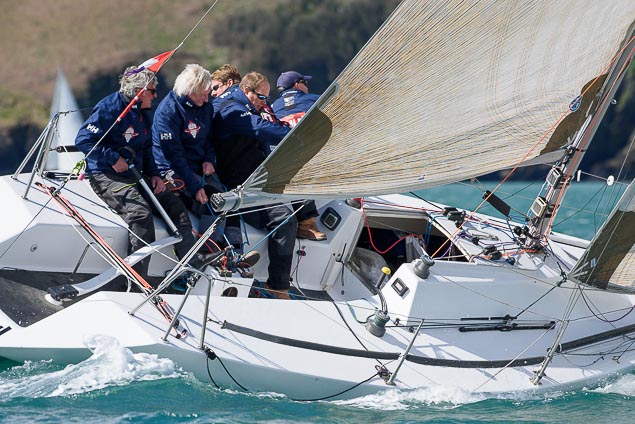 Kinsale Boats Headcase and Diamond (pictured above) dominate Class Three with Headcase ahead by 2 points going into the last day. Photo: Bob Bateman
Kinsale Boats Headcase and Diamond (pictured above) dominate Class Three with Headcase ahead by 2 points going into the last day. Photo: Bob Bateman
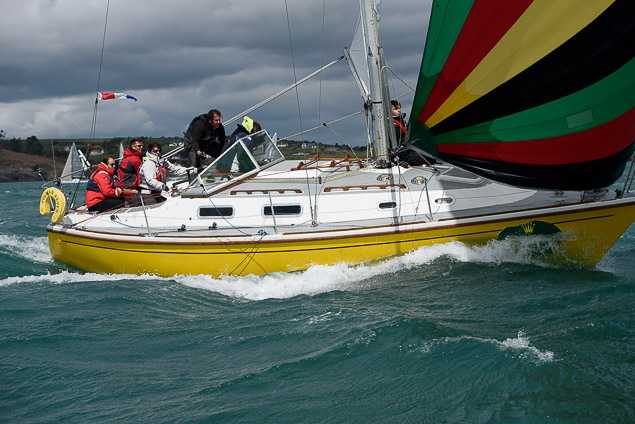 Fulmar Fever (R Marchant) competing in today's Kinsale Yacht Club April League. Photo: Bob Bateman
Fulmar Fever (R Marchant) competing in today's Kinsale Yacht Club April League. Photo: Bob Bateman
The strong breeze may have favoured the big boats but it was spills and thrills in class three with skilled sailors who knew their boats well showing others how to organise the many spinnaker hoists required.
Two races were sailed and careful race management ensured that the whole fleet were alongside KYC marina in plenty of time to see the Munster match on TV.
"In Class one, the duel continued between Nieulargo and Jump Juice who now have 11 points each with Alpaca third on 15 points"
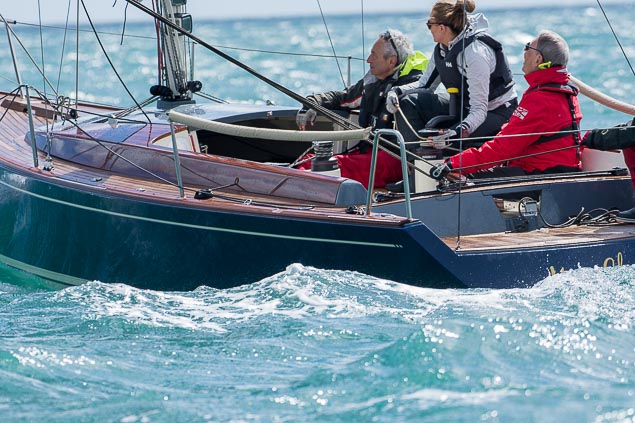 A classic Tofinou day yacht competing in the Kinsale Series Photo: Bob Bateman
A classic Tofinou day yacht competing in the Kinsale Series Photo: Bob Bateman
In Class one, the duel continued between Nieulargo and Jump Juice who now have 11 points each with Alpaca third on 15 points.
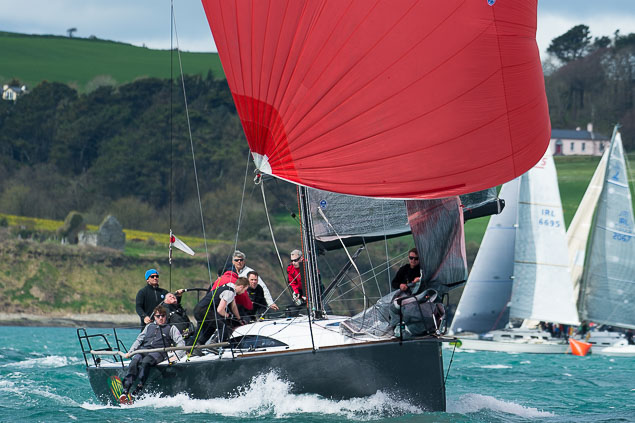 Royal Cork's Jump Juice skippered by Conor Phelan Photo: Bob Bateman
Royal Cork's Jump Juice skippered by Conor Phelan Photo: Bob Bateman
Class Two’s Oracle IV has an impressive lead over Artful Dodger and Slack Alice who only have a point between them.
Kinsale Boats Headcase and Diamond dominate Class Three with Headcase ahead by 2 points going into the last day. Waterford Boats Fulmar Fever and Flyer are drawn at 18 points each.
Godot leads the White Sail fleet every day on the water but on corrected it’s Sweet Dreams and Gunsmoke 2 who are in the running for first place overall with Godot third.
It’s all to sail for next Saturday 28th April with the final two races planned by race officer Denis Kieran. The FG is at 1155 HRS.
Scroll down for overall results at the end of day three at the bottom of this post
Day three photos by Bob Bateman:
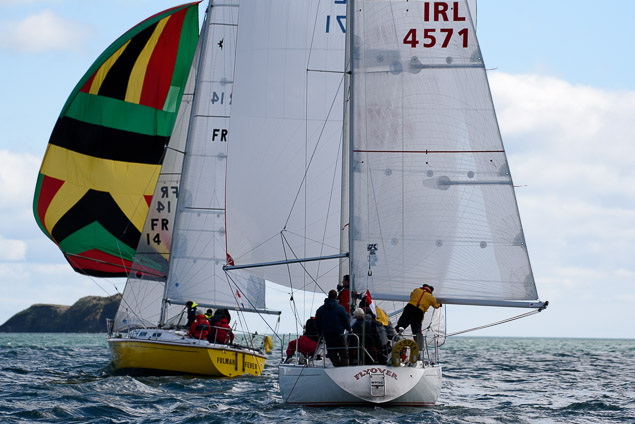
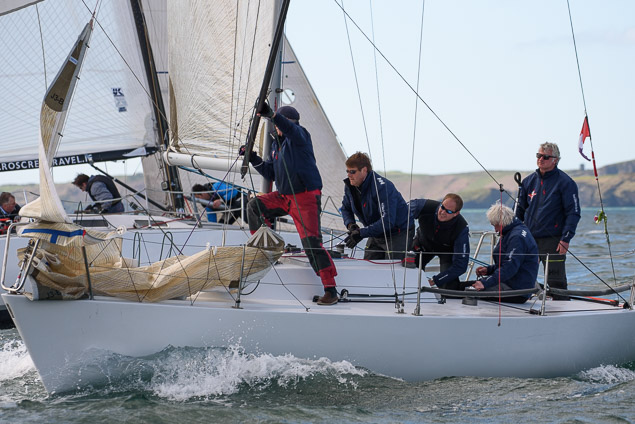
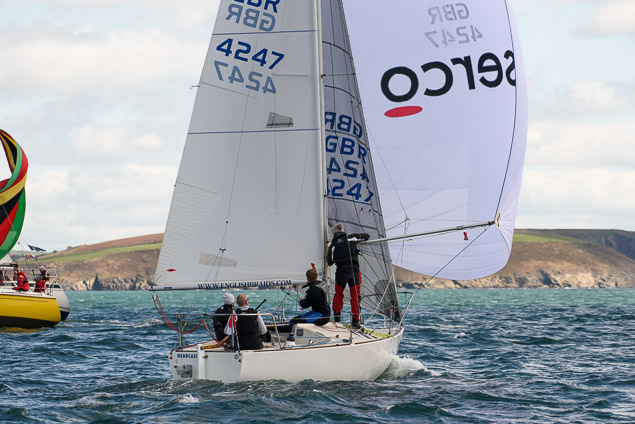
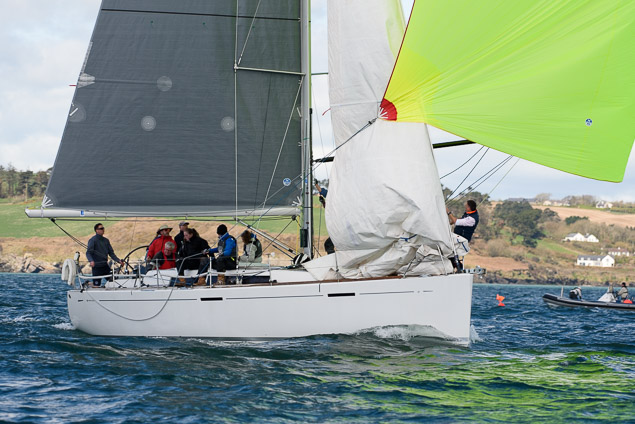
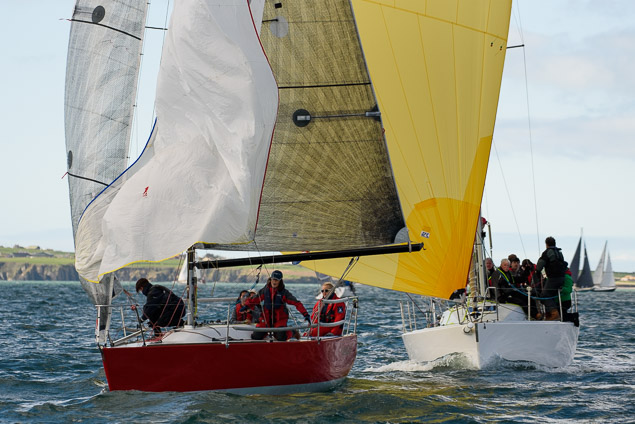
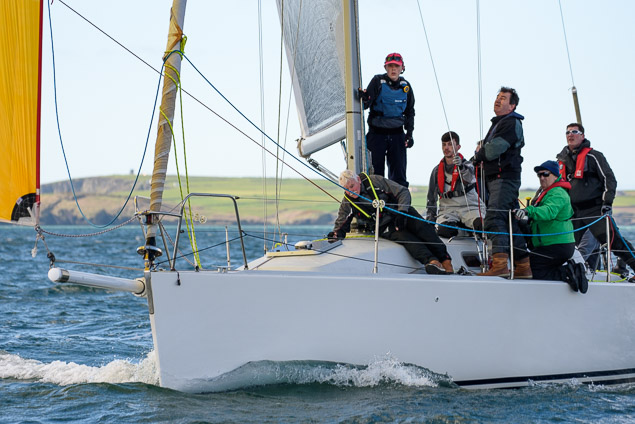
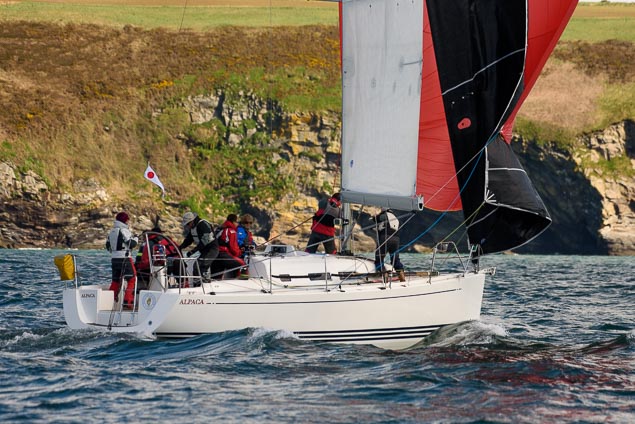
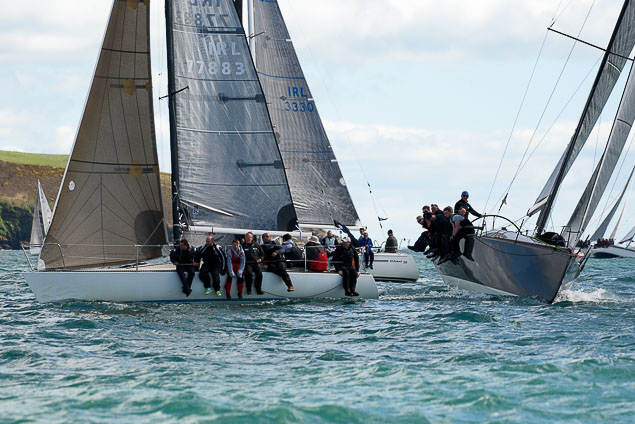
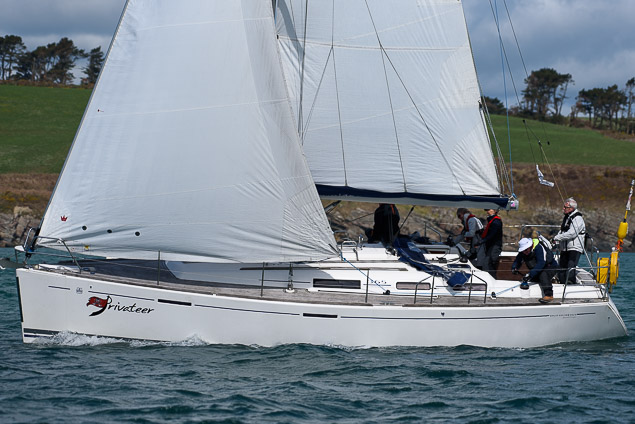
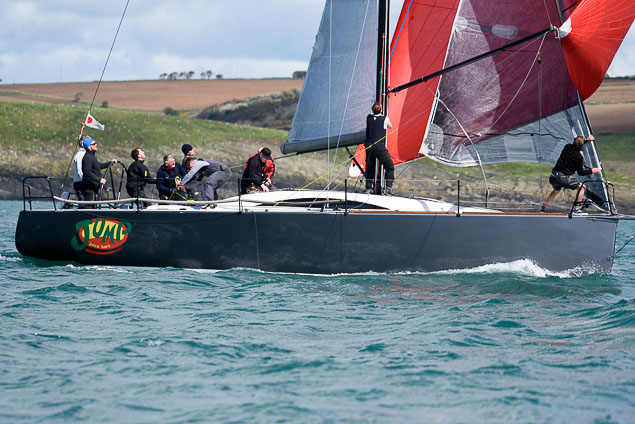
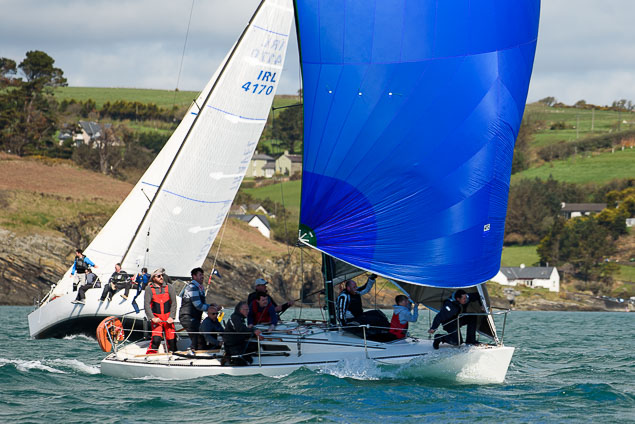
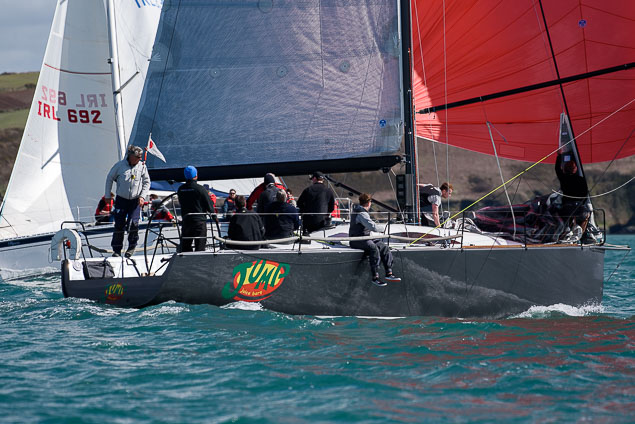
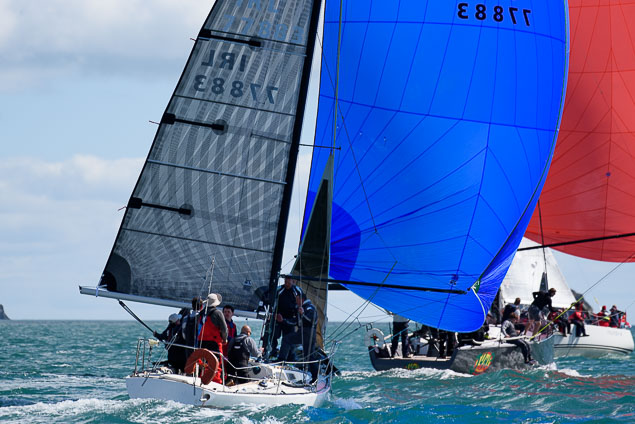
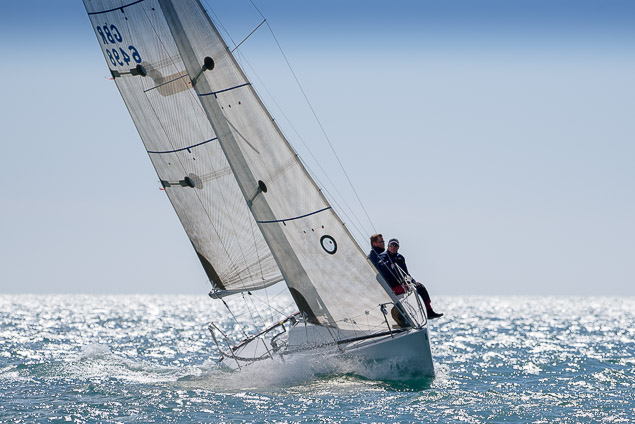
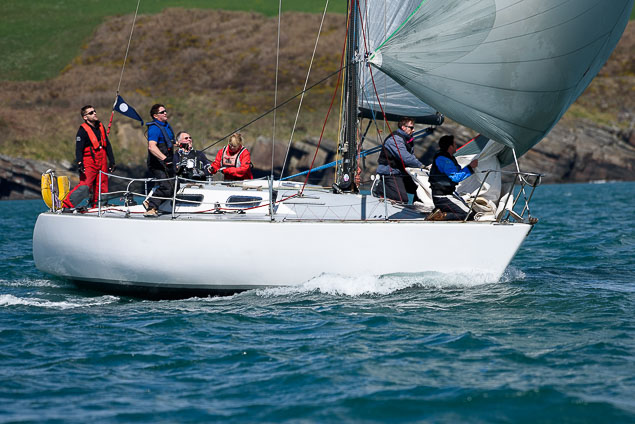
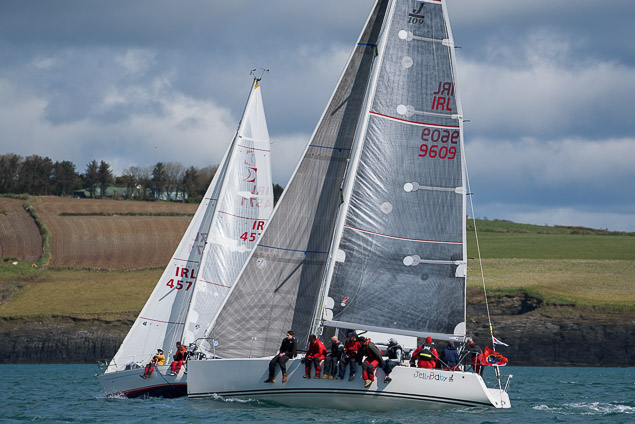
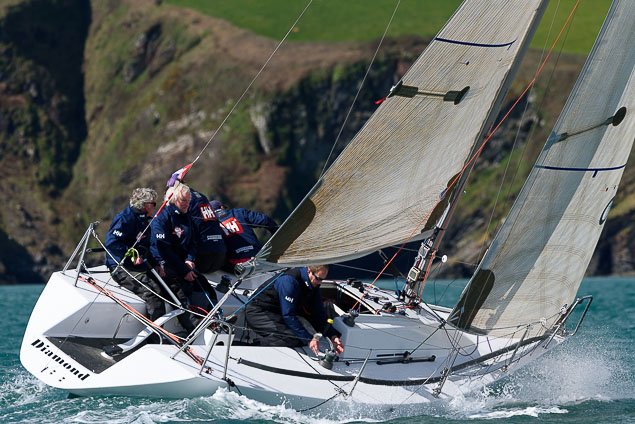
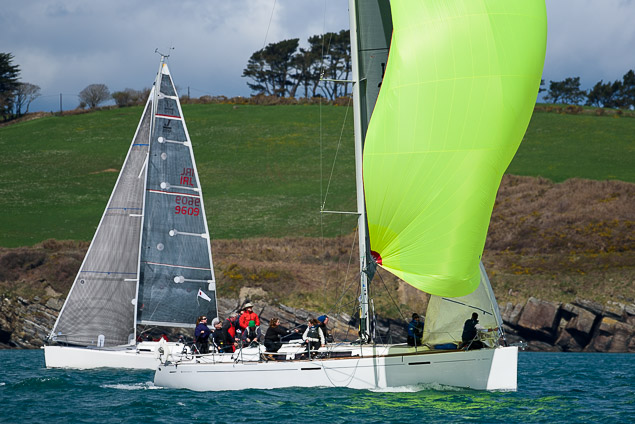
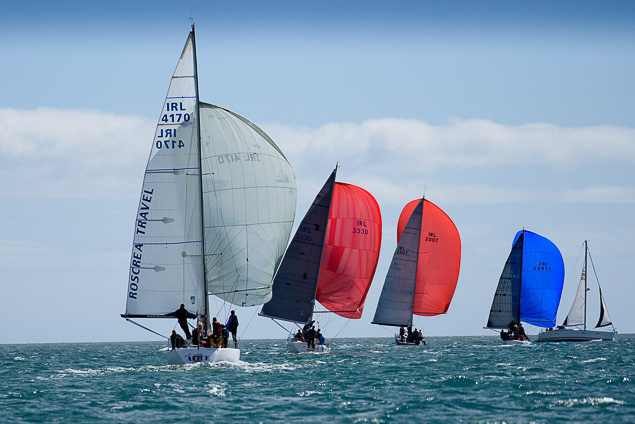
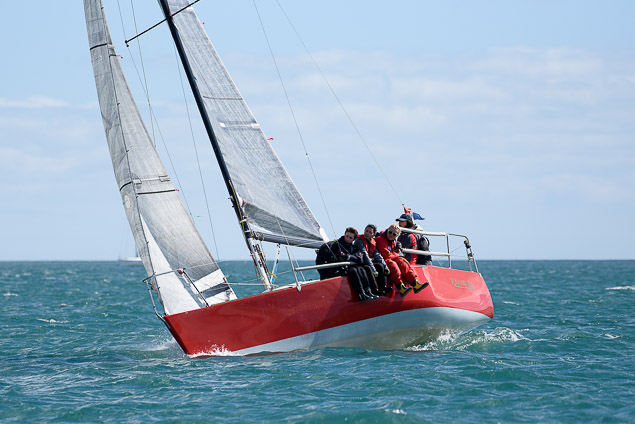
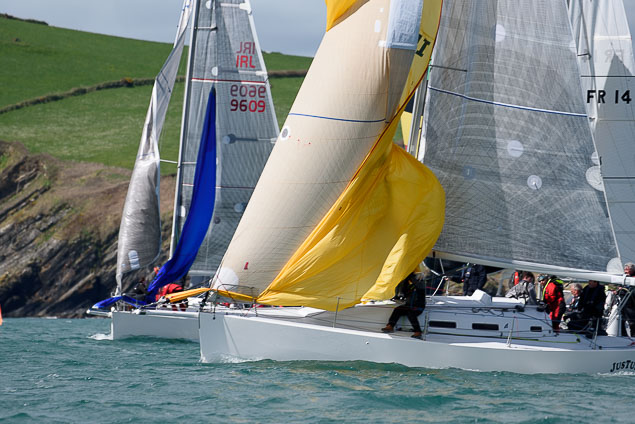
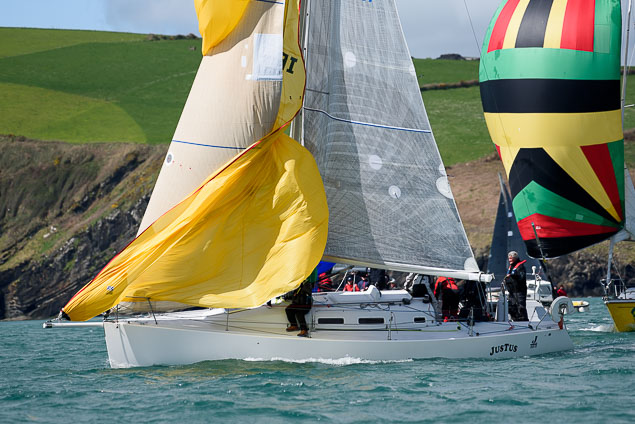
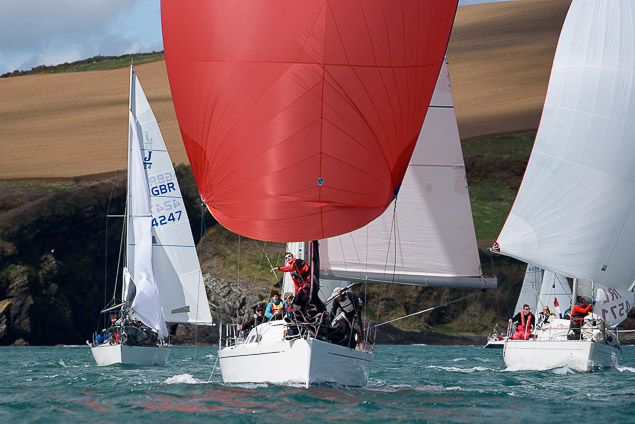
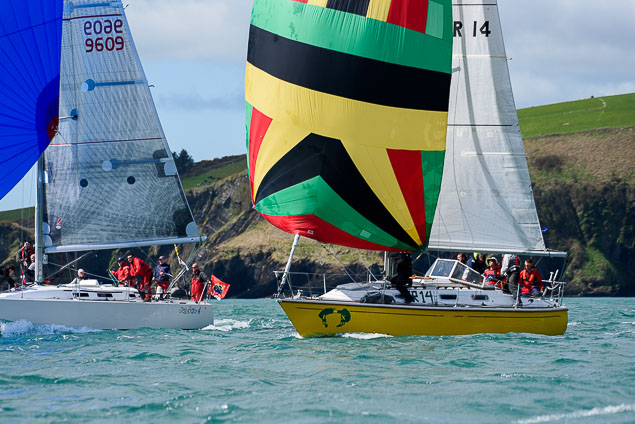
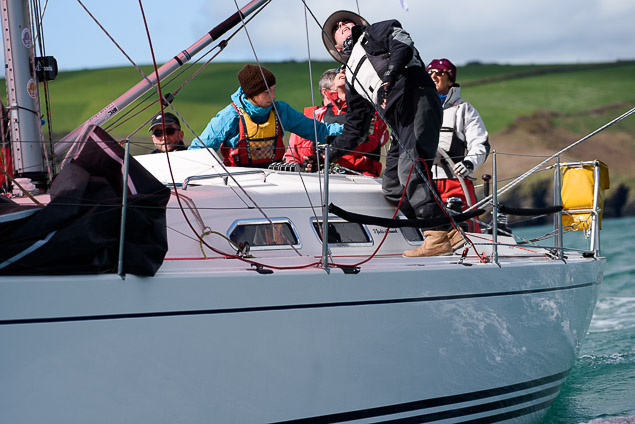
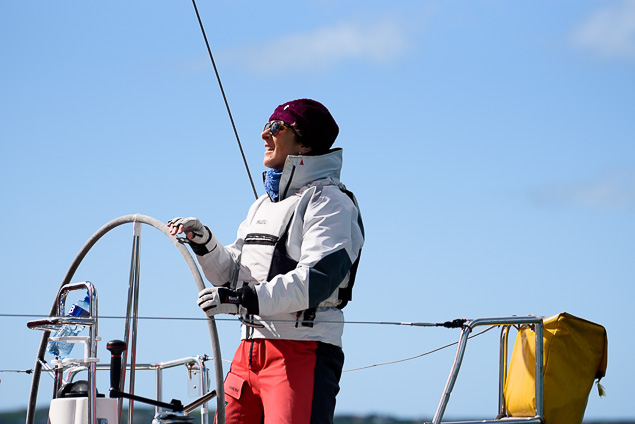
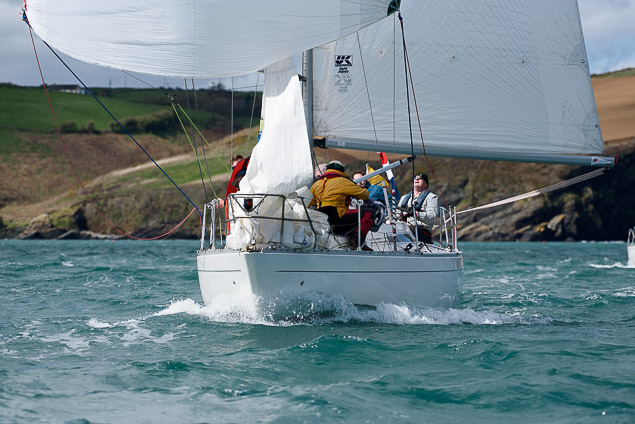
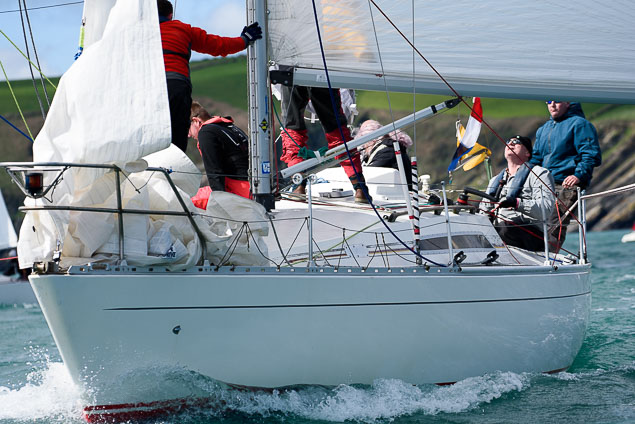
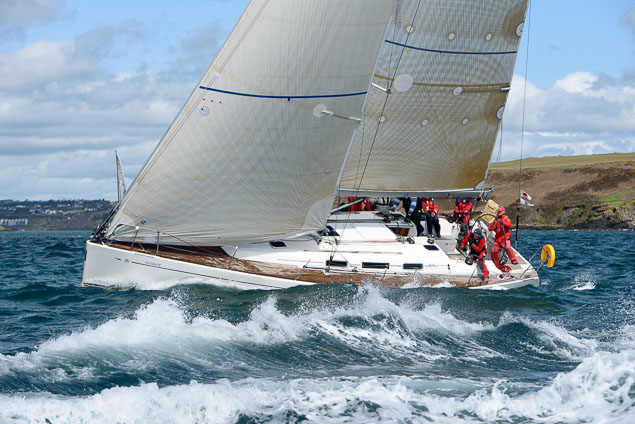
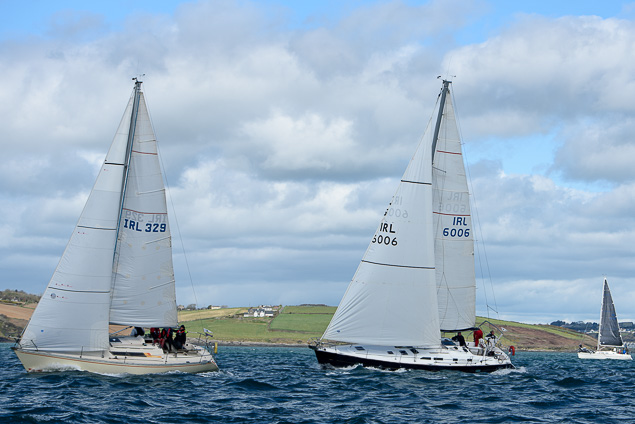
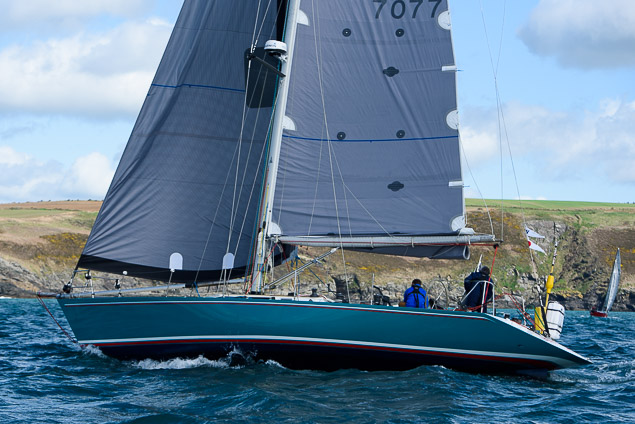
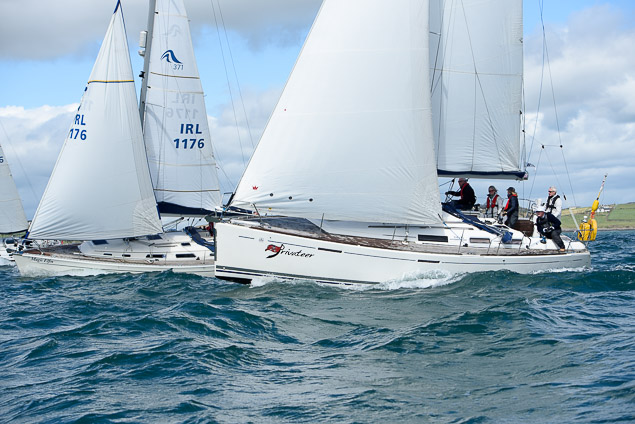
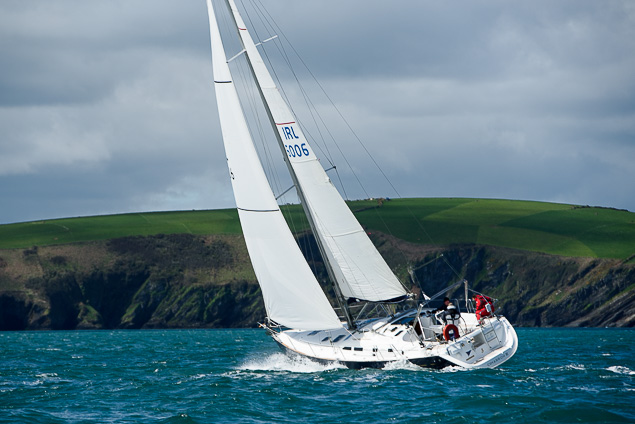
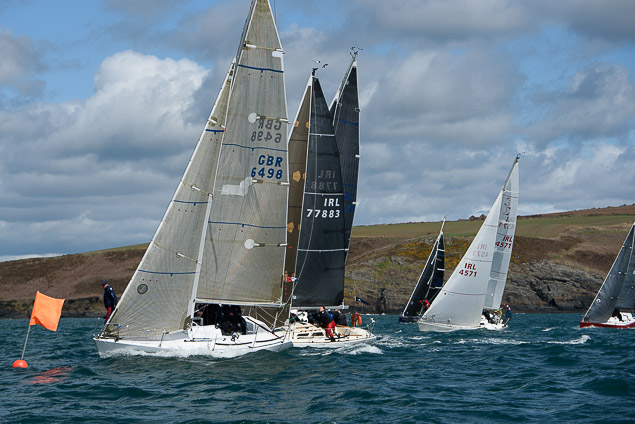
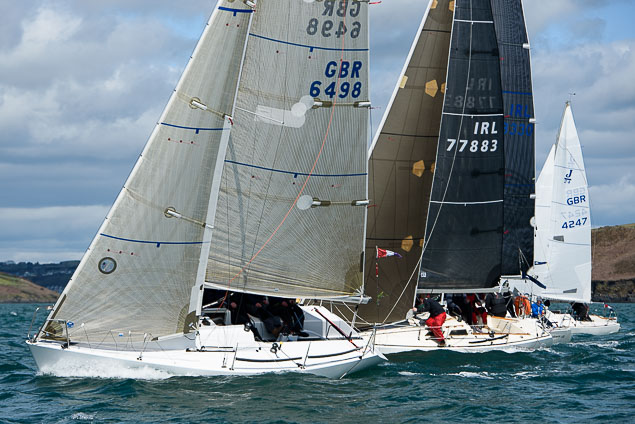
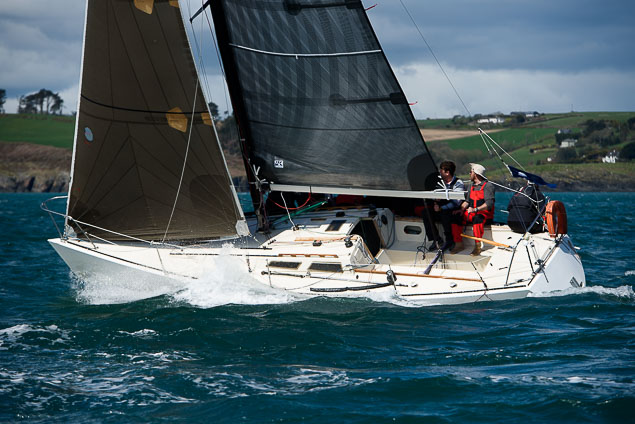
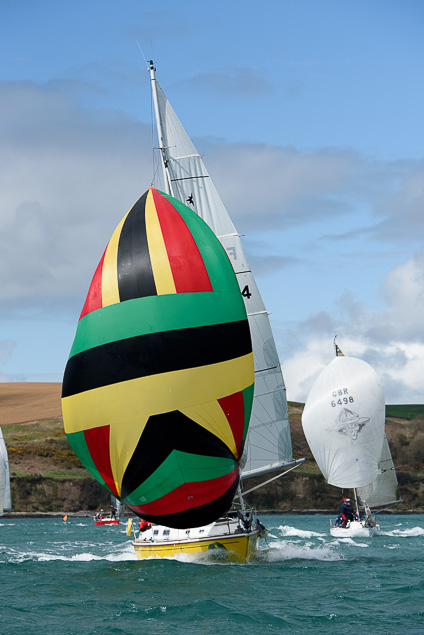
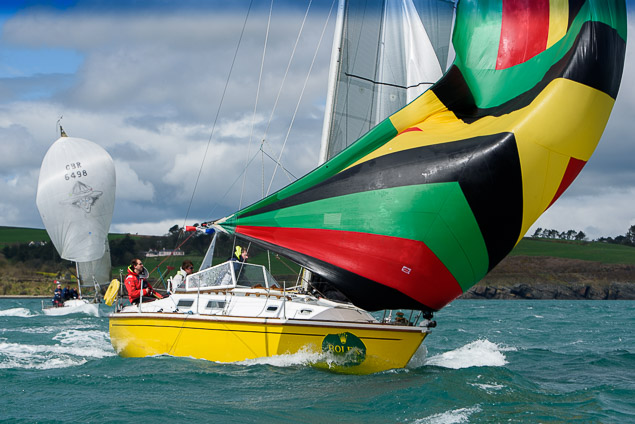
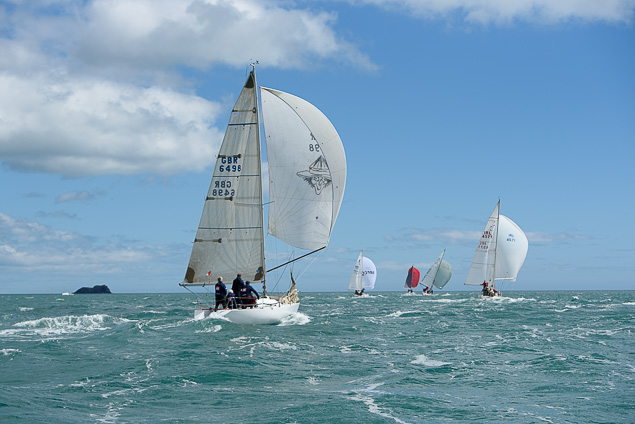
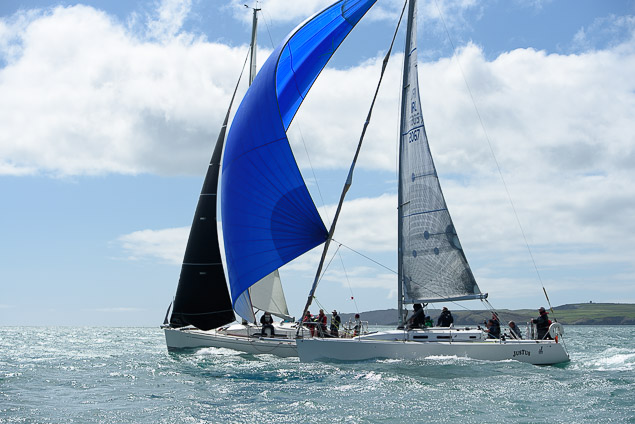
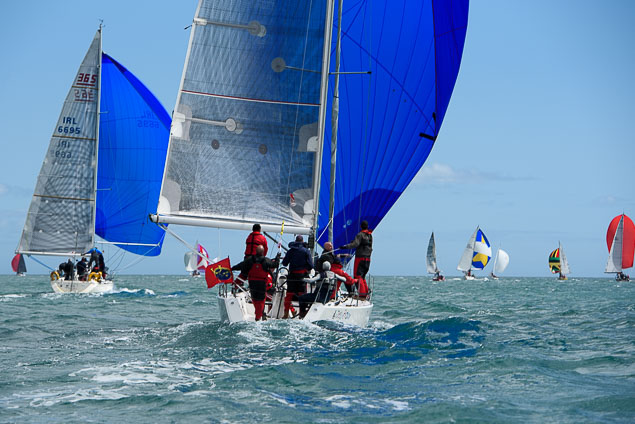
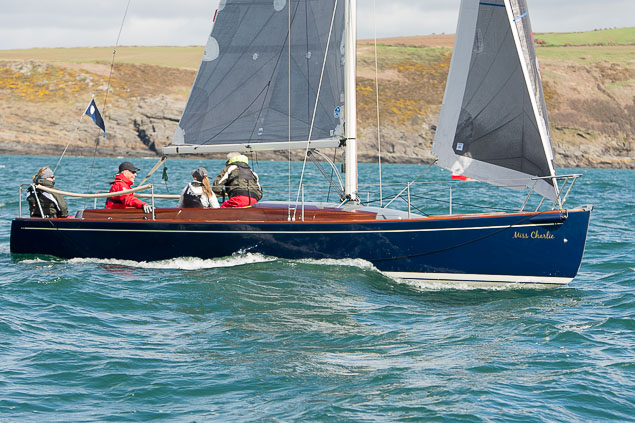
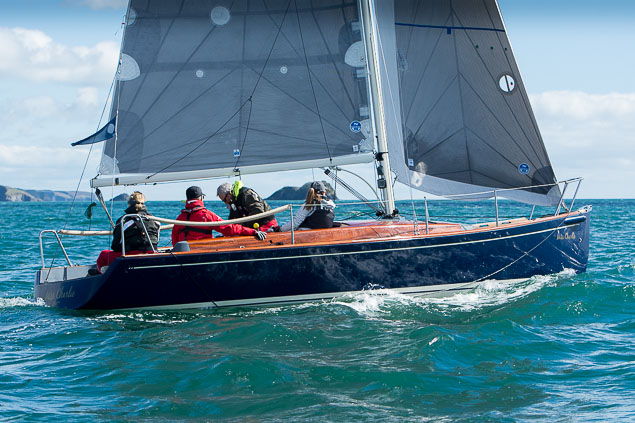
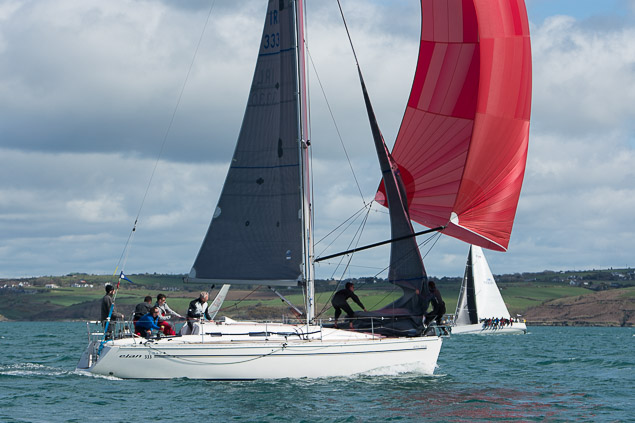
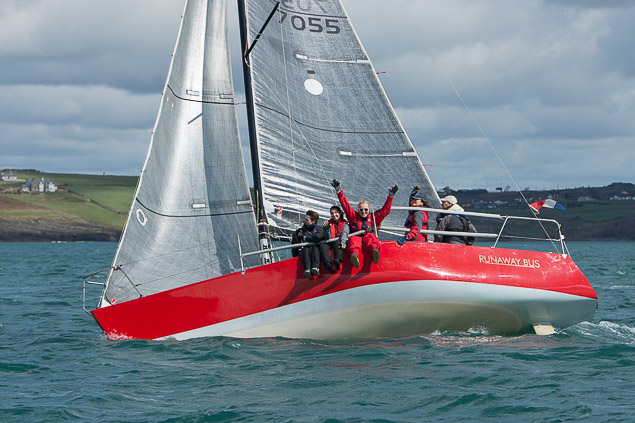
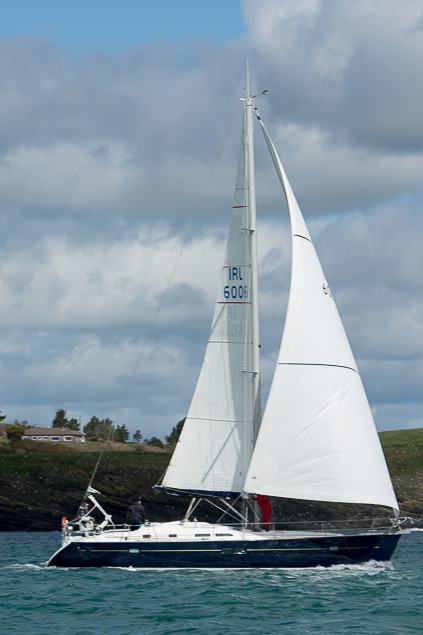
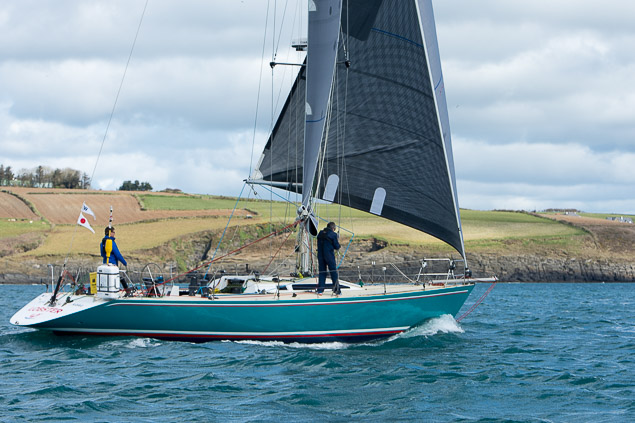
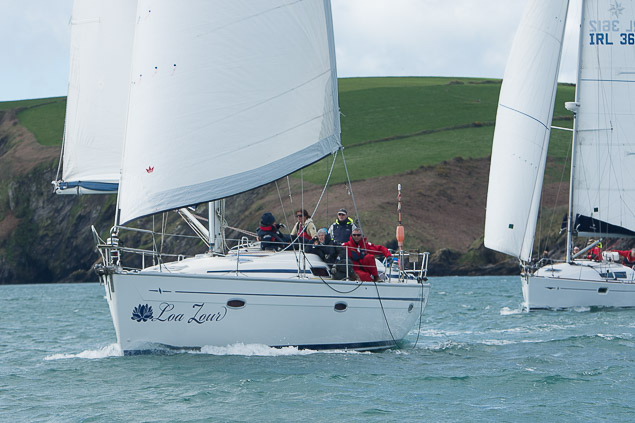
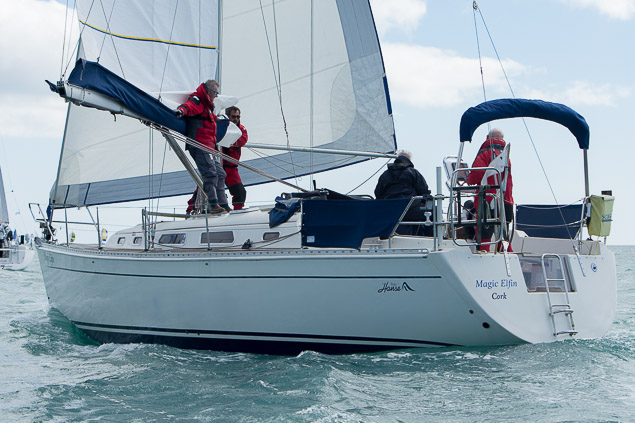
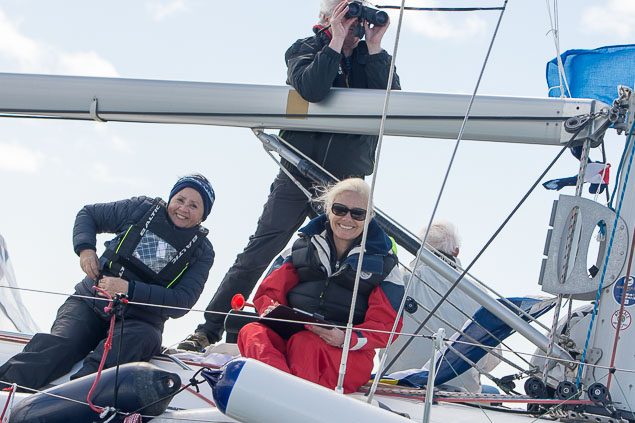
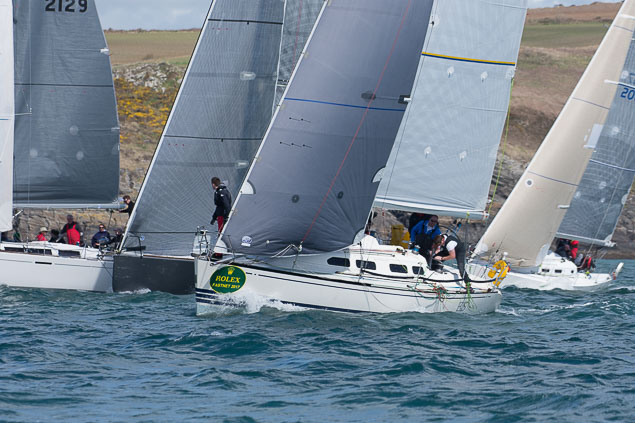
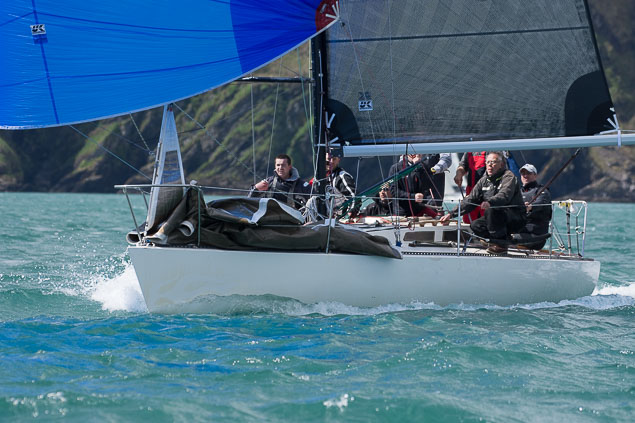
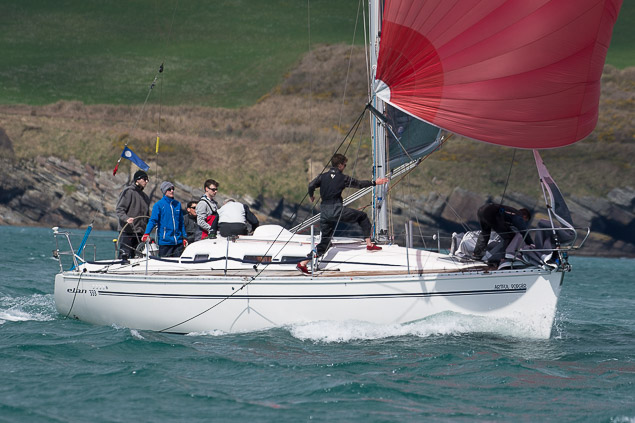
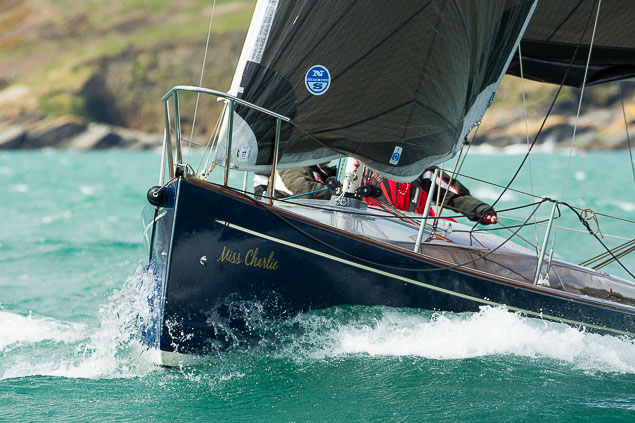
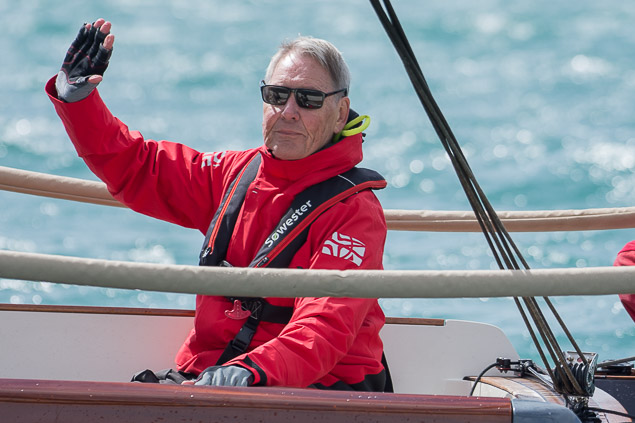
Class One IRC and ECHO
Nieulargo D Murphy
Jump Juice C Phelan
Alpaca P Tingle
Class Two IRC
Oracle IV - K Collins
Artful Dodger - F O’Regan
Slack Alice - S Stratham
Class Two ECHO
Slack Alice - S Stratham
Oracle IV - K Collins
Artful Dodger - F O’Regan
Class Three IRC
Headcase - M Helsten
Diamond - J Matthews
Fulmar Fever - R Marchant
Class Three ECHO
Headcase - M Hellstern
Fulmar Fever - R Marchant
Diamond - J Matthews
White sail IRC
Gunsmoke 2 - S Cohan
Sweet Dreams - B O’Leary
Godot - J Godkin
White Sail Echo
Sweet Dreams - B O’Leary
Gunsmoke 2 - S Cohen
Godot - J Godkin
Breezy Racing at Kinsale Yacht Club Frostbites
Having lost two weeks racing in the Kinsale Yacht Club Frostbite Series to weather, PRO John Stallard was determined to get some racing in this week. With temperatures in the low single digits and considerable wind chill the fleets, 10 Squibs, 6 Toppers and 5 Mixed Dinghies, took to the water in Kinsale today. The wind was blowing from the South East at 17 knots, gusting 23 – 26 knots and the decision was made to move the racing area to the inner harbour.
FG at was at 10.55hrs and the Squibs got away on time. Fuggles, Jeff Condell & Jeff Cochrane, lead from the start with Badger, Rob Doyle & Rob Gill, Fifty Shades, Cliodhna & Finbarr O’Regan, and Allegro, Colm Dunne & Fiona Ward all close on his heels. Fuggles held off the competition with Badger 2nd and Allegro 3rd. Race 2 got underway immediately after the finish. This time it was Allegro who took the lead and rounded the windward mark first, however Fuggles over took him on the 2nd beat by going up the left side of the course and he secured another 1st, Allegro 2nd and Fifty Shades was 3rd. Race 3 saw the same finishing order for the top 3 and this was enough for Fuggles to take the lead overall with Fifty Shades lying 2nd and Allegro 3rd. With less than 2 minutes separating the top 6 Squibs this fleet has gotten very competitive and should make for a great season ahead.
The Mixed Dinghies were again dominated by Micheal O’Suilleabhain & Michael Carroll in the 420 – they were planing up wind today – and they secured two bullets. Sean Collins in the Laser Radial was 2nd in the first race today and was in a good position to take 2nd in the second race until he capsized, the gusty winds made for a difficult righting and this allowed Tom Good in the Laser 4.7 to overtake him and secure 2nd. Georgina Griffin in the 2.4m bravely stayed the course for both races.
The Topper fleet has several newcomers and today’s conditions were very challenging for them. For the first race we had several capsize. Dorothy Matthews got a great start and lead from the off. Rachel Akerlind was 2nd in Race 1 with Frances Corkery and Francesca Lewis 3rd and 4th and 2 DNF. Due to the cold and the strengthening wind 3 Toppers decided to retire before the start of the second race. John Stallard made the decision to give the Toppers just 1 round of the course and Dorothy Matthews again dominated with Francesca Lewis 2nd and Frances Corkery 3rd. As with the Mixed Dinghies the Toppers were sent home after the second race.
Many thanks to John Stallard and his race management team aboard Destiny – rumour has it people were multi tasking as they got 3 races completed in 1 hr 35 mins – and all the RIB drivers/crew for mark laying and safety boat duty, on what was probably the coldest Frostbite day ever.
Strong Winds & Snow Showers Scrub Sailing in Dublin & Cork
Strong and bitterly cold north-westerly winds scotched racing in Dublin Bay and Kinsale yesterday. Winds gusting to 30–knots in snow showers. it was more than enough to put paid to the second race of the DBSC Spring Chicken Series, the Kinsale Yacht Club Frostbite racing and yesterday afternoon's DMYC dinghy frostbite series in Dun Laoghaire Harbour too with an early call by organisers on Saturday night.
Go–ahead organiser Fintan Cairns went to sea with his 40–boat DBSC Spring Chicken fleet early yesterday morning and was on station in his DBSC Committee Boat Freebird but winds built to such an extent in the short time they were afloat that it left Cairns with no option but to 'pull it', as the fleet got ready for the second of six races in the popular warm-up to the DBSC Summer Series.
It was 'very cold, making the wind feel even heavier', Cairns told Afloat.ie




























